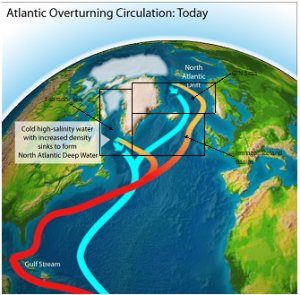Mechanisms of Low-Frequency Variability in North Atlantic Ocean Heat Transport and AMOC
Key Points & Overview
- Decadal natural variability in North Atlantic northward ocean heat transport (OHT) appears to be driven by strong northwesterly winds off eastern North America, which drive an increased Atlantic Meridional Overturning Circulation (AMOC) and associated ocean heat transport
- This mechanism holds across three climate models that differ in their representation of the water sinking that occurs in the subpolar North Atlantic, which is responsible for driving AMOC
- Given the clear link between variations in North Atlantic OHT, AMOC and the sinking of Labrador Sea water, it is likely that future CO2 induced changes in this sinking will impact OHT and AMOC, and North Atlantic climate as a result

The oceans play an important role in global climate due to their transport of heat from low to high latitudes. Atlantic meridional ocean heat transport (OHT) is particularly important due to the existence of a strong Atlantic meridional overturning circulation (AMOC), which plays a large role in moderating the European climate and is also known to affect the Arctic climate. AMOC is a system of North Atlantic currents characterised by warm northward flowing water at the surface and cold southward flowing water at depth. As these warm currents move northwards, the water releases heat to the atmosphere and cools. As the water cools, it becomes more dense, eventually sinking and turning southwards after reaching the subpolar regions. AMOC and North Atlantic OHT are closely linked to the strength of this sinking. Different climate models have distinct representations of this sinking, particularly its magnitude and its location. Several models show sinking primarily in the Labrador Sea, while several others show it primarily in the Irminger and Iceland Basins, and others show it mainly in the Greenland-Iceland-Norwegian Seas (GIN Seas; see Figure). There is a lot of debate about which of these sinking regions drive AMOC and its low-frequency variability. In many models, AMOC and its associated OHT are driven mostly by sinking in the Labrador Sea, but several recent observational studies have shown that the GIN Seas are much more important. In this paper, the goal was to determine what drives low-frequency variations in North Atlantic OHT, and whether the mechanisms held in three models with different representations of time-mean sinking in North Atlantic subpolar regions.
This paper was written in collaboration with my PhD advisers, Professors Kyle Armour and LuAnne Thompson, as well as Robert Jnglin Wills, who used similar methods in several of his previous papers and inspired this analysis, and Laura Jackson, who became a co-author after providing a very helpful review of the paper.
In this paper, we document a mechanism that drives low-frequency variations in North Atlantic OHT. Our analysis used a novel method called a low-frequency component analysis (LFCA) to compute a mode of variability of North Atlantic OHT that maximises the ratio of low-frequency variance to total variance in the data. Then we analysed lead-lag regressions of different surface variables onto this mode of variability, called a low-frequency component. We determined that low-frequency OHT variability is primarily driven by strong northwesterly winds off eastern North America, which cool and densify the Labrador Sea waters, increasing the sinking in that region. This increased sinking strengthens AMOC, which leads to an increased OHT. The strengthened AMOC and OHT carry more warm water northwards into the Labrador Sea, causing a reduction in sinking, and hence a weakening of AMOC and OHT. These mechanisms, with AMOC largely driven by Labrador Sea changes, largely hold true for all three models, despite the fact that the Labrador Sea dominates time-mean sinking in only one of the models. Given this result, and the fact that one of the models used here has been shown to reproduce observed subpolar AMOC, it is likely that the mechanisms described are representative of natural processes. Because of the close link between changes in AMOC, OHT and Labrador Sea sinking, it is likely that future changes in this sinking, possibly induced by climate change, will affect AMOC and OHT, and hence North Atlantic climate due to OHT and AMOC’s role in driving changes in climate.
Authors and Affiliations: Dylan Oldenburg (UW School of Oceanography), Robert Jnglin Wills (UW Atmospheric Sciences), Kyle Armour (UW School of Oceanography and UW Atmospheric Sciences), LuAnne Thompson (UW School of Oceanography), Laura Jackson (Met Office Hadley Centre)